Analysis of Employee Development at Sainsbury's: A Research Project
VerifiedAdded on 2022/11/29
|24
|4976
|218
Report
AI Summary
This research project investigates the role of leaders and managers in employee development within Sainsbury's. The study begins with an introduction outlining the research aim, rationale, questions, and objectives. A comprehensive literature review explores the concept of employee development, strategies employed by Sainsbury's managers, and the challenges encountered during implementation. The methodology section details the research approach (deductive), strategy (primary and secondary), and methodology (quantitative). It describes the research instruments, sampling techniques (random sampling with 30 staff members), and ethical considerations. The findings, presented through frequency distribution tables, reveal insights into employee knowledge, the role of leaders and managers, strategies used, benefits gained, and issues faced. Data analysis and presentation are provided, followed by a discussion of the findings and their interpretation. The report concludes with recommendations and implications for further research, offering valuable insights into enhancing employee development practices. The research also includes a detailed methodology section, ethical considerations, and data analysis, making it a comprehensive study of employee development in the retail sector.
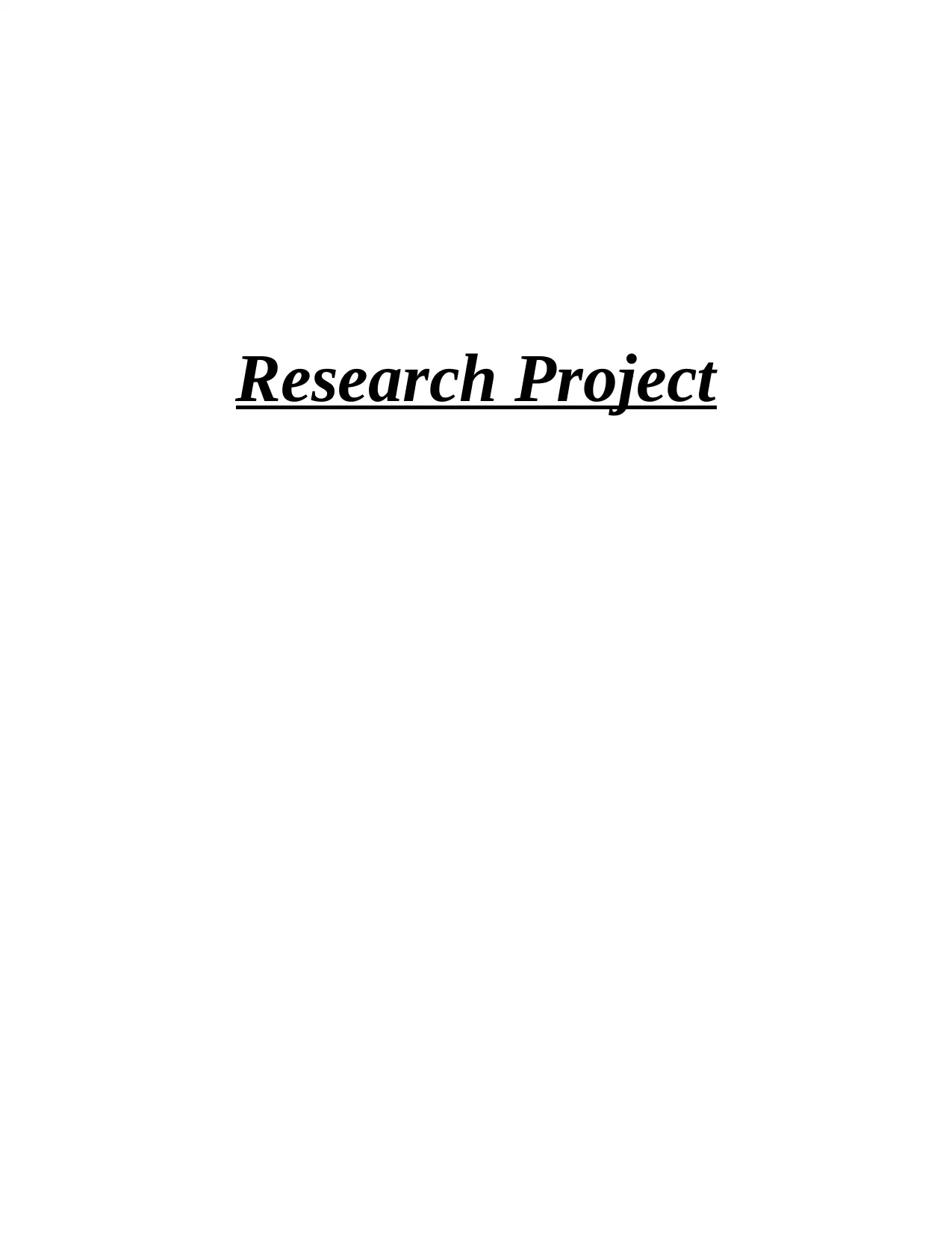
Research Project
Paraphrase This Document
Need a fresh take? Get an instant paraphrase of this document with our AI Paraphraser
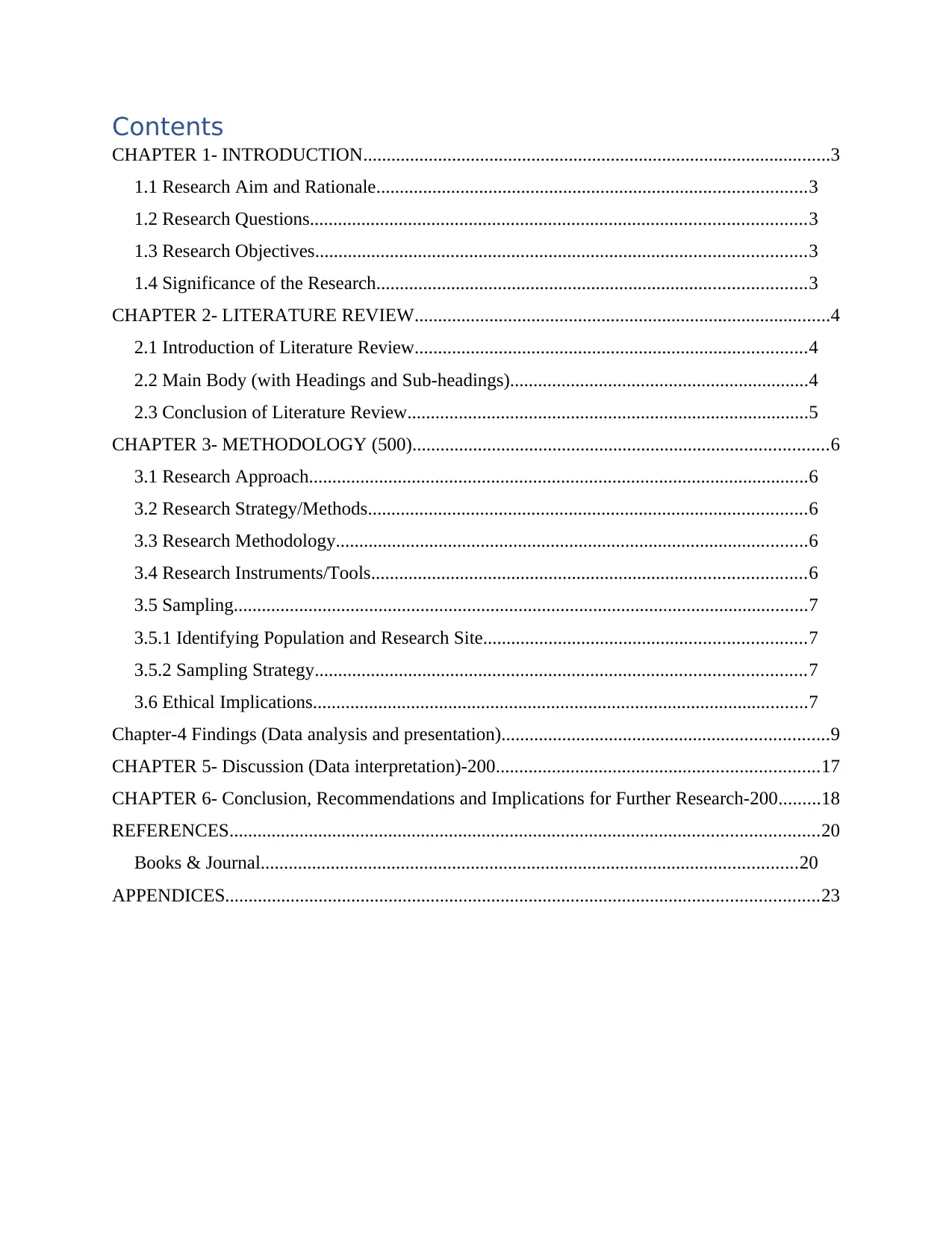
Contents
CHAPTER 1- INTRODUCTION....................................................................................................3
1.1 Research Aim and Rationale............................................................................................3
1.2 Research Questions..........................................................................................................3
1.3 Research Objectives.........................................................................................................3
1.4 Significance of the Research............................................................................................3
CHAPTER 2- LITERATURE REVIEW.........................................................................................4
2.1 Introduction of Literature Review....................................................................................4
2.2 Main Body (with Headings and Sub-headings)................................................................4
2.3 Conclusion of Literature Review......................................................................................5
CHAPTER 3- METHODOLOGY (500).........................................................................................6
3.1 Research Approach...........................................................................................................6
3.2 Research Strategy/Methods..............................................................................................6
3.3 Research Methodology.....................................................................................................6
3.4 Research Instruments/Tools.............................................................................................6
3.5 Sampling...........................................................................................................................7
3.5.1 Identifying Population and Research Site.....................................................................7
3.5.2 Sampling Strategy.........................................................................................................7
3.6 Ethical Implications..........................................................................................................7
Chapter-4 Findings (Data analysis and presentation)......................................................................9
CHAPTER 5- Discussion (Data interpretation)-200.....................................................................17
CHAPTER 6- Conclusion, Recommendations and Implications for Further Research-200.........18
REFERENCES..............................................................................................................................20
Books & Journal...................................................................................................................20
APPENDICES...............................................................................................................................23
CHAPTER 1- INTRODUCTION....................................................................................................3
1.1 Research Aim and Rationale............................................................................................3
1.2 Research Questions..........................................................................................................3
1.3 Research Objectives.........................................................................................................3
1.4 Significance of the Research............................................................................................3
CHAPTER 2- LITERATURE REVIEW.........................................................................................4
2.1 Introduction of Literature Review....................................................................................4
2.2 Main Body (with Headings and Sub-headings)................................................................4
2.3 Conclusion of Literature Review......................................................................................5
CHAPTER 3- METHODOLOGY (500).........................................................................................6
3.1 Research Approach...........................................................................................................6
3.2 Research Strategy/Methods..............................................................................................6
3.3 Research Methodology.....................................................................................................6
3.4 Research Instruments/Tools.............................................................................................6
3.5 Sampling...........................................................................................................................7
3.5.1 Identifying Population and Research Site.....................................................................7
3.5.2 Sampling Strategy.........................................................................................................7
3.6 Ethical Implications..........................................................................................................7
Chapter-4 Findings (Data analysis and presentation)......................................................................9
CHAPTER 5- Discussion (Data interpretation)-200.....................................................................17
CHAPTER 6- Conclusion, Recommendations and Implications for Further Research-200.........18
REFERENCES..............................................................................................................................20
Books & Journal...................................................................................................................20
APPENDICES...............................................................................................................................23
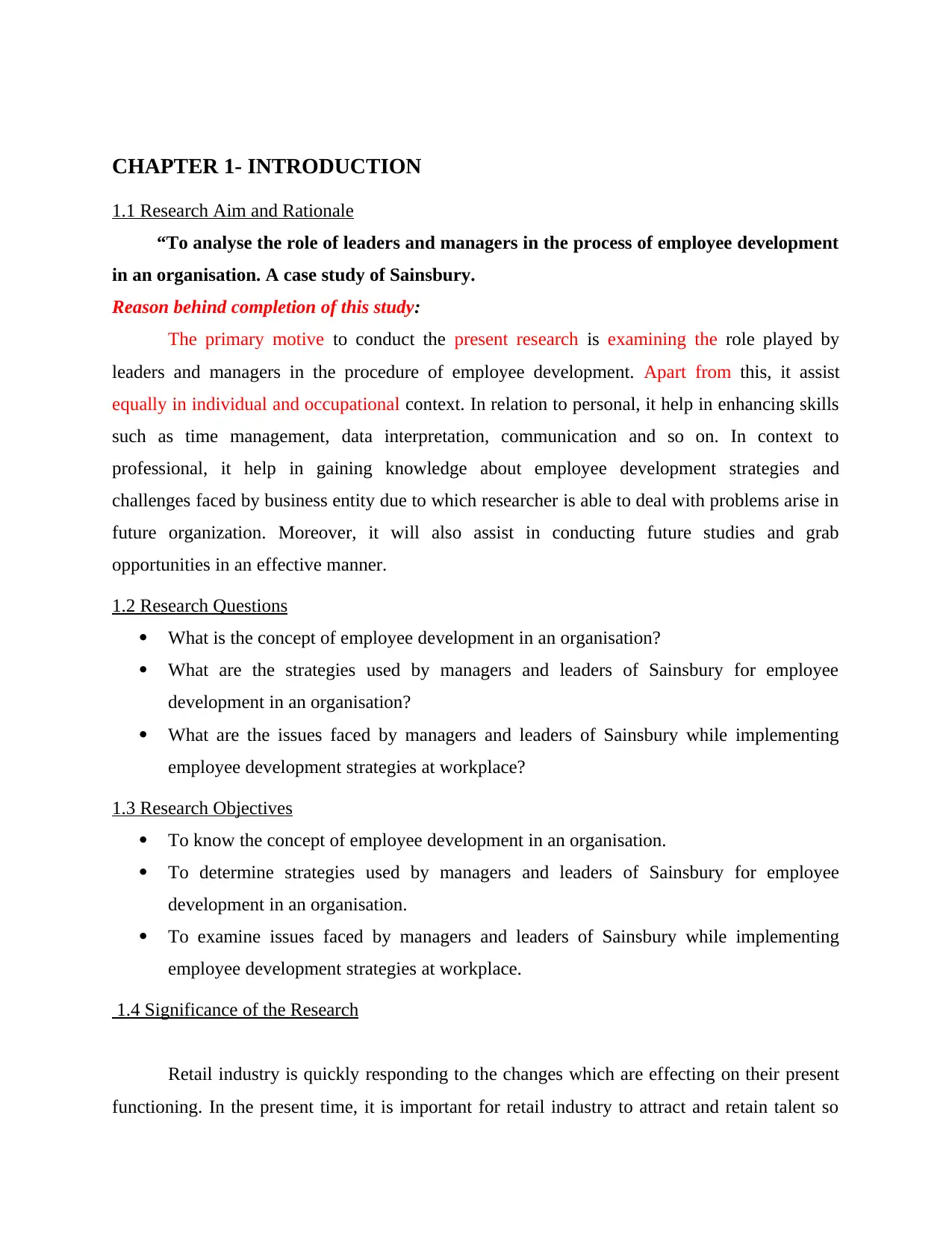
CHAPTER 1- INTRODUCTION
1.1 Research Aim and Rationale
“To analyse the role of leaders and managers in the process of employee development
in an organisation. A case study of Sainsbury.
Reason behind completion of this study:
The primary motive to conduct the present research is examining the role played by
leaders and managers in the procedure of employee development. Apart from this, it assist
equally in individual and occupational context. In relation to personal, it help in enhancing skills
such as time management, data interpretation, communication and so on. In context to
professional, it help in gaining knowledge about employee development strategies and
challenges faced by business entity due to which researcher is able to deal with problems arise in
future organization. Moreover, it will also assist in conducting future studies and grab
opportunities in an effective manner.
1.2 Research Questions
What is the concept of employee development in an organisation?
What are the strategies used by managers and leaders of Sainsbury for employee
development in an organisation?
What are the issues faced by managers and leaders of Sainsbury while implementing
employee development strategies at workplace?
1.3 Research Objectives
To know the concept of employee development in an organisation.
To determine strategies used by managers and leaders of Sainsbury for employee
development in an organisation.
To examine issues faced by managers and leaders of Sainsbury while implementing
employee development strategies at workplace.
1.4 Significance of the Research
Retail industry is quickly responding to the changes which are effecting on their present
functioning. In the present time, it is important for retail industry to attract and retain talent so
1.1 Research Aim and Rationale
“To analyse the role of leaders and managers in the process of employee development
in an organisation. A case study of Sainsbury.
Reason behind completion of this study:
The primary motive to conduct the present research is examining the role played by
leaders and managers in the procedure of employee development. Apart from this, it assist
equally in individual and occupational context. In relation to personal, it help in enhancing skills
such as time management, data interpretation, communication and so on. In context to
professional, it help in gaining knowledge about employee development strategies and
challenges faced by business entity due to which researcher is able to deal with problems arise in
future organization. Moreover, it will also assist in conducting future studies and grab
opportunities in an effective manner.
1.2 Research Questions
What is the concept of employee development in an organisation?
What are the strategies used by managers and leaders of Sainsbury for employee
development in an organisation?
What are the issues faced by managers and leaders of Sainsbury while implementing
employee development strategies at workplace?
1.3 Research Objectives
To know the concept of employee development in an organisation.
To determine strategies used by managers and leaders of Sainsbury for employee
development in an organisation.
To examine issues faced by managers and leaders of Sainsbury while implementing
employee development strategies at workplace.
1.4 Significance of the Research
Retail industry is quickly responding to the changes which are effecting on their present
functioning. In the present time, it is important for retail industry to attract and retain talent so
⊘ This is a preview!⊘
Do you want full access?
Subscribe today to unlock all pages.

Trusted by 1+ million students worldwide
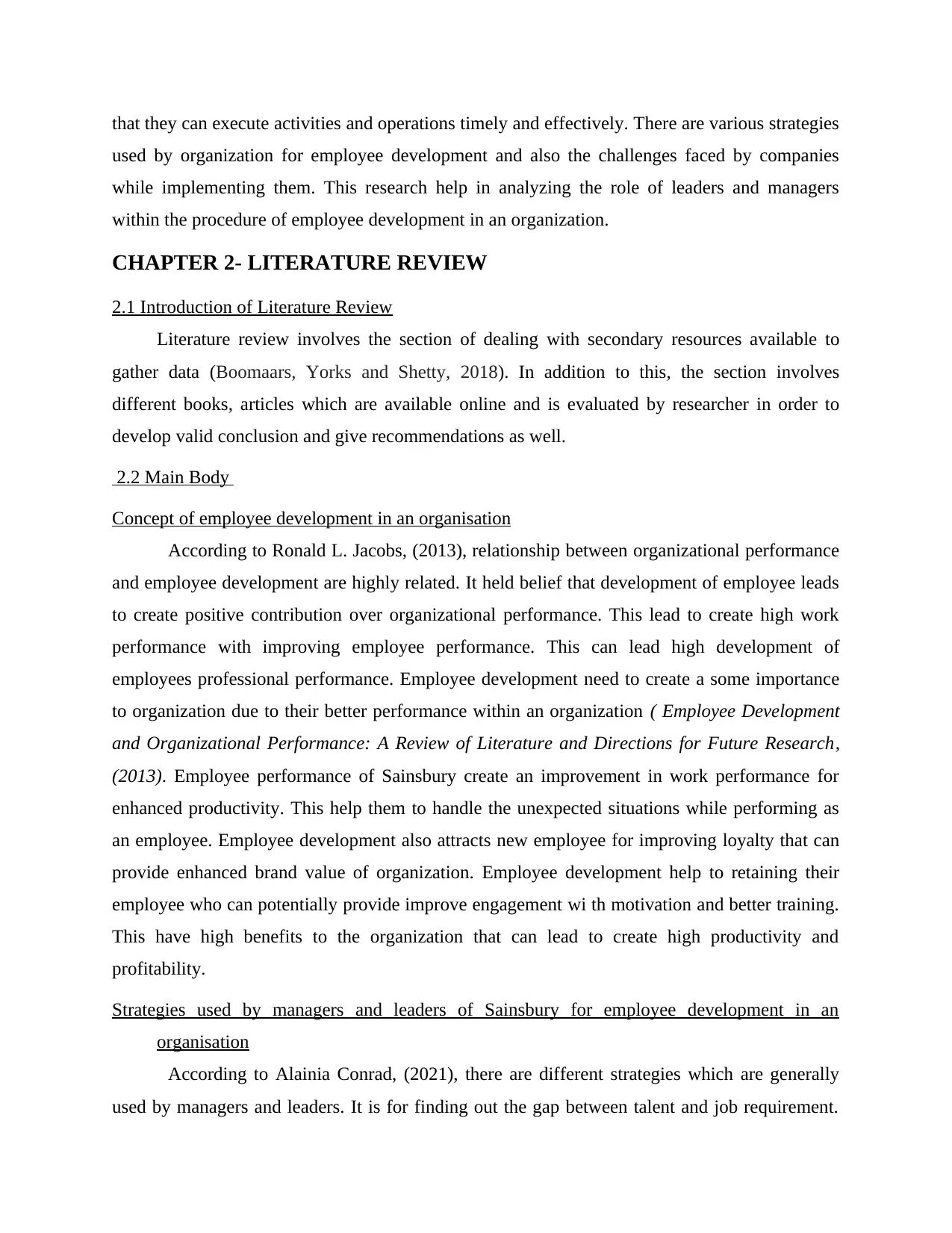
that they can execute activities and operations timely and effectively. There are various strategies
used by organization for employee development and also the challenges faced by companies
while implementing them. This research help in analyzing the role of leaders and managers
within the procedure of employee development in an organization.
CHAPTER 2- LITERATURE REVIEW
2.1 Introduction of Literature Review
Literature review involves the section of dealing with secondary resources available to
gather data (Boomaars, Yorks and Shetty, 2018). In addition to this, the section involves
different books, articles which are available online and is evaluated by researcher in order to
develop valid conclusion and give recommendations as well.
2.2 Main Body
Concept of employee development in an organisation
According to Ronald L. Jacobs, (2013), relationship between organizational performance
and employee development are highly related. It held belief that development of employee leads
to create positive contribution over organizational performance. This lead to create high work
performance with improving employee performance. This can lead high development of
employees professional performance. Employee development need to create a some importance
to organization due to their better performance within an organization ( Employee Development
and Organizational Performance: A Review of Literature and Directions for Future Research,
(2013). Employee performance of Sainsbury create an improvement in work performance for
enhanced productivity. This help them to handle the unexpected situations while performing as
an employee. Employee development also attracts new employee for improving loyalty that can
provide enhanced brand value of organization. Employee development help to retaining their
employee who can potentially provide improve engagement wi th motivation and better training.
This have high benefits to the organization that can lead to create high productivity and
profitability.
Strategies used by managers and leaders of Sainsbury for employee development in an
organisation
According to Alainia Conrad, (2021), there are different strategies which are generally
used by managers and leaders. It is for finding out the gap between talent and job requirement.
used by organization for employee development and also the challenges faced by companies
while implementing them. This research help in analyzing the role of leaders and managers
within the procedure of employee development in an organization.
CHAPTER 2- LITERATURE REVIEW
2.1 Introduction of Literature Review
Literature review involves the section of dealing with secondary resources available to
gather data (Boomaars, Yorks and Shetty, 2018). In addition to this, the section involves
different books, articles which are available online and is evaluated by researcher in order to
develop valid conclusion and give recommendations as well.
2.2 Main Body
Concept of employee development in an organisation
According to Ronald L. Jacobs, (2013), relationship between organizational performance
and employee development are highly related. It held belief that development of employee leads
to create positive contribution over organizational performance. This lead to create high work
performance with improving employee performance. This can lead high development of
employees professional performance. Employee development need to create a some importance
to organization due to their better performance within an organization ( Employee Development
and Organizational Performance: A Review of Literature and Directions for Future Research,
(2013). Employee performance of Sainsbury create an improvement in work performance for
enhanced productivity. This help them to handle the unexpected situations while performing as
an employee. Employee development also attracts new employee for improving loyalty that can
provide enhanced brand value of organization. Employee development help to retaining their
employee who can potentially provide improve engagement wi th motivation and better training.
This have high benefits to the organization that can lead to create high productivity and
profitability.
Strategies used by managers and leaders of Sainsbury for employee development in an
organisation
According to Alainia Conrad, (2021), there are different strategies which are generally
used by managers and leaders. It is for finding out the gap between talent and job requirement.
Paraphrase This Document
Need a fresh take? Get an instant paraphrase of this document with our AI Paraphraser
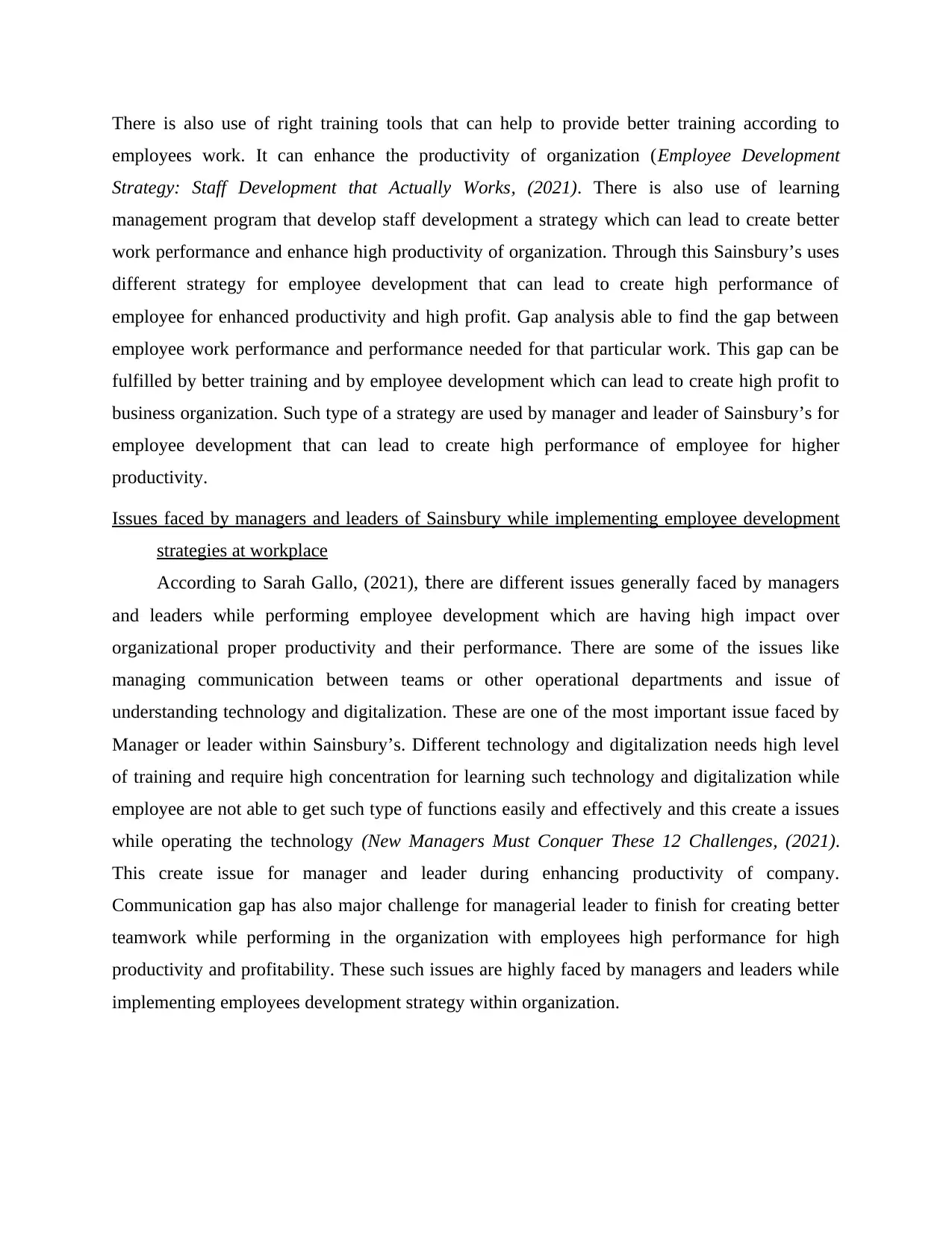
There is also use of right training tools that can help to provide better training according to
employees work. It can enhance the productivity of organization (Employee Development
Strategy: Staff Development that Actually Works, (2021). There is also use of learning
management program that develop staff development a strategy which can lead to create better
work performance and enhance high productivity of organization. Through this Sainsbury’s uses
different strategy for employee development that can lead to create high performance of
employee for enhanced productivity and high profit. Gap analysis able to find the gap between
employee work performance and performance needed for that particular work. This gap can be
fulfilled by better training and by employee development which can lead to create high profit to
business organization. Such type of a strategy are used by manager and leader of Sainsbury’s for
employee development that can lead to create high performance of employee for higher
productivity.
Issues faced by managers and leaders of Sainsbury while implementing employee development
strategies at workplace
According to Sarah Gallo, (2021), there are different issues generally faced by managers
and leaders while performing employee development which are having high impact over
organizational proper productivity and their performance. There are some of the issues like
managing communication between teams or other operational departments and issue of
understanding technology and digitalization. These are one of the most important issue faced by
Manager or leader within Sainsbury’s. Different technology and digitalization needs high level
of training and require high concentration for learning such technology and digitalization while
employee are not able to get such type of functions easily and effectively and this create a issues
while operating the technology (New Managers Must Conquer These 12 Challenges, (2021).
This create issue for manager and leader during enhancing productivity of company.
Communication gap has also major challenge for managerial leader to finish for creating better
teamwork while performing in the organization with employees high performance for high
productivity and profitability. These such issues are highly faced by managers and leaders while
implementing employees development strategy within organization.
employees work. It can enhance the productivity of organization (Employee Development
Strategy: Staff Development that Actually Works, (2021). There is also use of learning
management program that develop staff development a strategy which can lead to create better
work performance and enhance high productivity of organization. Through this Sainsbury’s uses
different strategy for employee development that can lead to create high performance of
employee for enhanced productivity and high profit. Gap analysis able to find the gap between
employee work performance and performance needed for that particular work. This gap can be
fulfilled by better training and by employee development which can lead to create high profit to
business organization. Such type of a strategy are used by manager and leader of Sainsbury’s for
employee development that can lead to create high performance of employee for higher
productivity.
Issues faced by managers and leaders of Sainsbury while implementing employee development
strategies at workplace
According to Sarah Gallo, (2021), there are different issues generally faced by managers
and leaders while performing employee development which are having high impact over
organizational proper productivity and their performance. There are some of the issues like
managing communication between teams or other operational departments and issue of
understanding technology and digitalization. These are one of the most important issue faced by
Manager or leader within Sainsbury’s. Different technology and digitalization needs high level
of training and require high concentration for learning such technology and digitalization while
employee are not able to get such type of functions easily and effectively and this create a issues
while operating the technology (New Managers Must Conquer These 12 Challenges, (2021).
This create issue for manager and leader during enhancing productivity of company.
Communication gap has also major challenge for managerial leader to finish for creating better
teamwork while performing in the organization with employees high performance for high
productivity and profitability. These such issues are highly faced by managers and leaders while
implementing employees development strategy within organization.
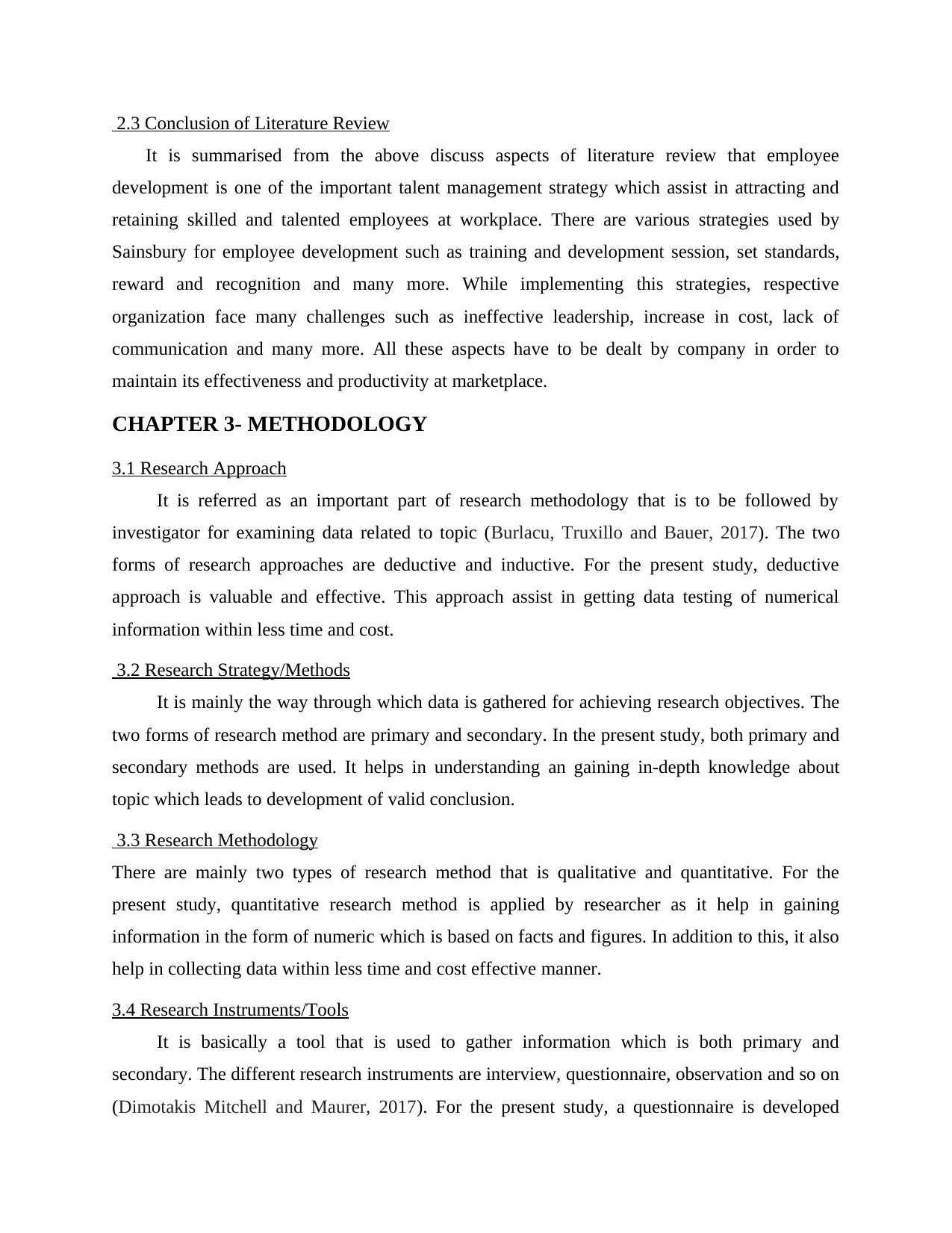
2.3 Conclusion of Literature Review
It is summarised from the above discuss aspects of literature review that employee
development is one of the important talent management strategy which assist in attracting and
retaining skilled and talented employees at workplace. There are various strategies used by
Sainsbury for employee development such as training and development session, set standards,
reward and recognition and many more. While implementing this strategies, respective
organization face many challenges such as ineffective leadership, increase in cost, lack of
communication and many more. All these aspects have to be dealt by company in order to
maintain its effectiveness and productivity at marketplace.
CHAPTER 3- METHODOLOGY
3.1 Research Approach
It is referred as an important part of research methodology that is to be followed by
investigator for examining data related to topic (Burlacu, Truxillo and Bauer, 2017). The two
forms of research approaches are deductive and inductive. For the present study, deductive
approach is valuable and effective. This approach assist in getting data testing of numerical
information within less time and cost.
3.2 Research Strategy/Methods
It is mainly the way through which data is gathered for achieving research objectives. The
two forms of research method are primary and secondary. In the present study, both primary and
secondary methods are used. It helps in understanding an gaining in-depth knowledge about
topic which leads to development of valid conclusion.
3.3 Research Methodology
There are mainly two types of research method that is qualitative and quantitative. For the
present study, quantitative research method is applied by researcher as it help in gaining
information in the form of numeric which is based on facts and figures. In addition to this, it also
help in collecting data within less time and cost effective manner.
3.4 Research Instruments/Tools
It is basically a tool that is used to gather information which is both primary and
secondary. The different research instruments are interview, questionnaire, observation and so on
(Dimotakis Mitchell and Maurer, 2017). For the present study, a questionnaire is developed
It is summarised from the above discuss aspects of literature review that employee
development is one of the important talent management strategy which assist in attracting and
retaining skilled and talented employees at workplace. There are various strategies used by
Sainsbury for employee development such as training and development session, set standards,
reward and recognition and many more. While implementing this strategies, respective
organization face many challenges such as ineffective leadership, increase in cost, lack of
communication and many more. All these aspects have to be dealt by company in order to
maintain its effectiveness and productivity at marketplace.
CHAPTER 3- METHODOLOGY
3.1 Research Approach
It is referred as an important part of research methodology that is to be followed by
investigator for examining data related to topic (Burlacu, Truxillo and Bauer, 2017). The two
forms of research approaches are deductive and inductive. For the present study, deductive
approach is valuable and effective. This approach assist in getting data testing of numerical
information within less time and cost.
3.2 Research Strategy/Methods
It is mainly the way through which data is gathered for achieving research objectives. The
two forms of research method are primary and secondary. In the present study, both primary and
secondary methods are used. It helps in understanding an gaining in-depth knowledge about
topic which leads to development of valid conclusion.
3.3 Research Methodology
There are mainly two types of research method that is qualitative and quantitative. For the
present study, quantitative research method is applied by researcher as it help in gaining
information in the form of numeric which is based on facts and figures. In addition to this, it also
help in collecting data within less time and cost effective manner.
3.4 Research Instruments/Tools
It is basically a tool that is used to gather information which is both primary and
secondary. The different research instruments are interview, questionnaire, observation and so on
(Dimotakis Mitchell and Maurer, 2017). For the present study, a questionnaire is developed
⊘ This is a preview!⊘
Do you want full access?
Subscribe today to unlock all pages.

Trusted by 1+ million students worldwide
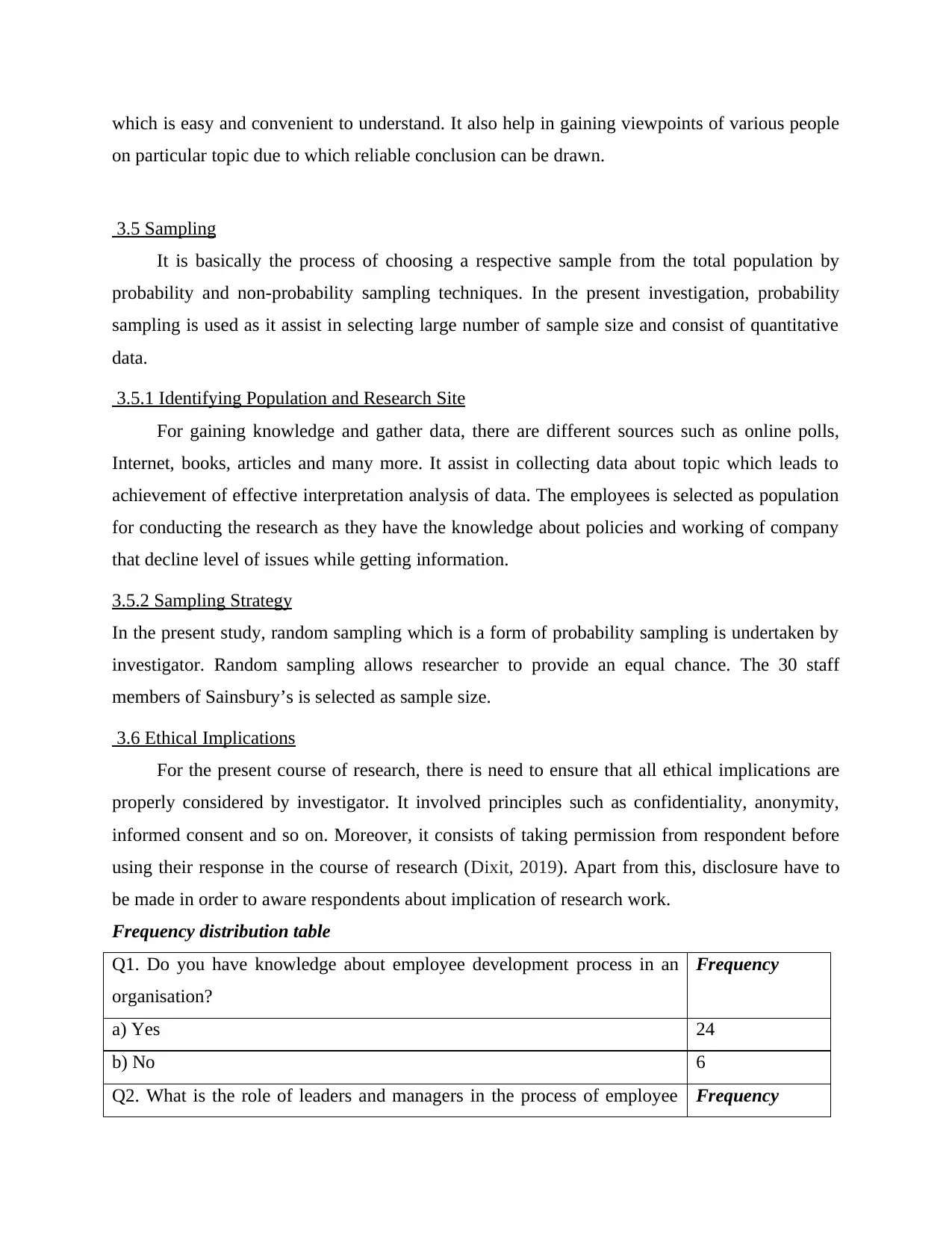
which is easy and convenient to understand. It also help in gaining viewpoints of various people
on particular topic due to which reliable conclusion can be drawn.
3.5 Sampling
It is basically the process of choosing a respective sample from the total population by
probability and non-probability sampling techniques. In the present investigation, probability
sampling is used as it assist in selecting large number of sample size and consist of quantitative
data.
3.5.1 Identifying Population and Research Site
For gaining knowledge and gather data, there are different sources such as online polls,
Internet, books, articles and many more. It assist in collecting data about topic which leads to
achievement of effective interpretation analysis of data. The employees is selected as population
for conducting the research as they have the knowledge about policies and working of company
that decline level of issues while getting information.
3.5.2 Sampling Strategy
In the present study, random sampling which is a form of probability sampling is undertaken by
investigator. Random sampling allows researcher to provide an equal chance. The 30 staff
members of Sainsbury’s is selected as sample size.
3.6 Ethical Implications
For the present course of research, there is need to ensure that all ethical implications are
properly considered by investigator. It involved principles such as confidentiality, anonymity,
informed consent and so on. Moreover, it consists of taking permission from respondent before
using their response in the course of research (Dixit, 2019). Apart from this, disclosure have to
be made in order to aware respondents about implication of research work.
Frequency distribution table
Q1. Do you have knowledge about employee development process in an
organisation?
Frequency
a) Yes 24
b) No 6
Q2. What is the role of leaders and managers in the process of employee Frequency
on particular topic due to which reliable conclusion can be drawn.
3.5 Sampling
It is basically the process of choosing a respective sample from the total population by
probability and non-probability sampling techniques. In the present investigation, probability
sampling is used as it assist in selecting large number of sample size and consist of quantitative
data.
3.5.1 Identifying Population and Research Site
For gaining knowledge and gather data, there are different sources such as online polls,
Internet, books, articles and many more. It assist in collecting data about topic which leads to
achievement of effective interpretation analysis of data. The employees is selected as population
for conducting the research as they have the knowledge about policies and working of company
that decline level of issues while getting information.
3.5.2 Sampling Strategy
In the present study, random sampling which is a form of probability sampling is undertaken by
investigator. Random sampling allows researcher to provide an equal chance. The 30 staff
members of Sainsbury’s is selected as sample size.
3.6 Ethical Implications
For the present course of research, there is need to ensure that all ethical implications are
properly considered by investigator. It involved principles such as confidentiality, anonymity,
informed consent and so on. Moreover, it consists of taking permission from respondent before
using their response in the course of research (Dixit, 2019). Apart from this, disclosure have to
be made in order to aware respondents about implication of research work.
Frequency distribution table
Q1. Do you have knowledge about employee development process in an
organisation?
Frequency
a) Yes 24
b) No 6
Q2. What is the role of leaders and managers in the process of employee Frequency
Paraphrase This Document
Need a fresh take? Get an instant paraphrase of this document with our AI Paraphraser
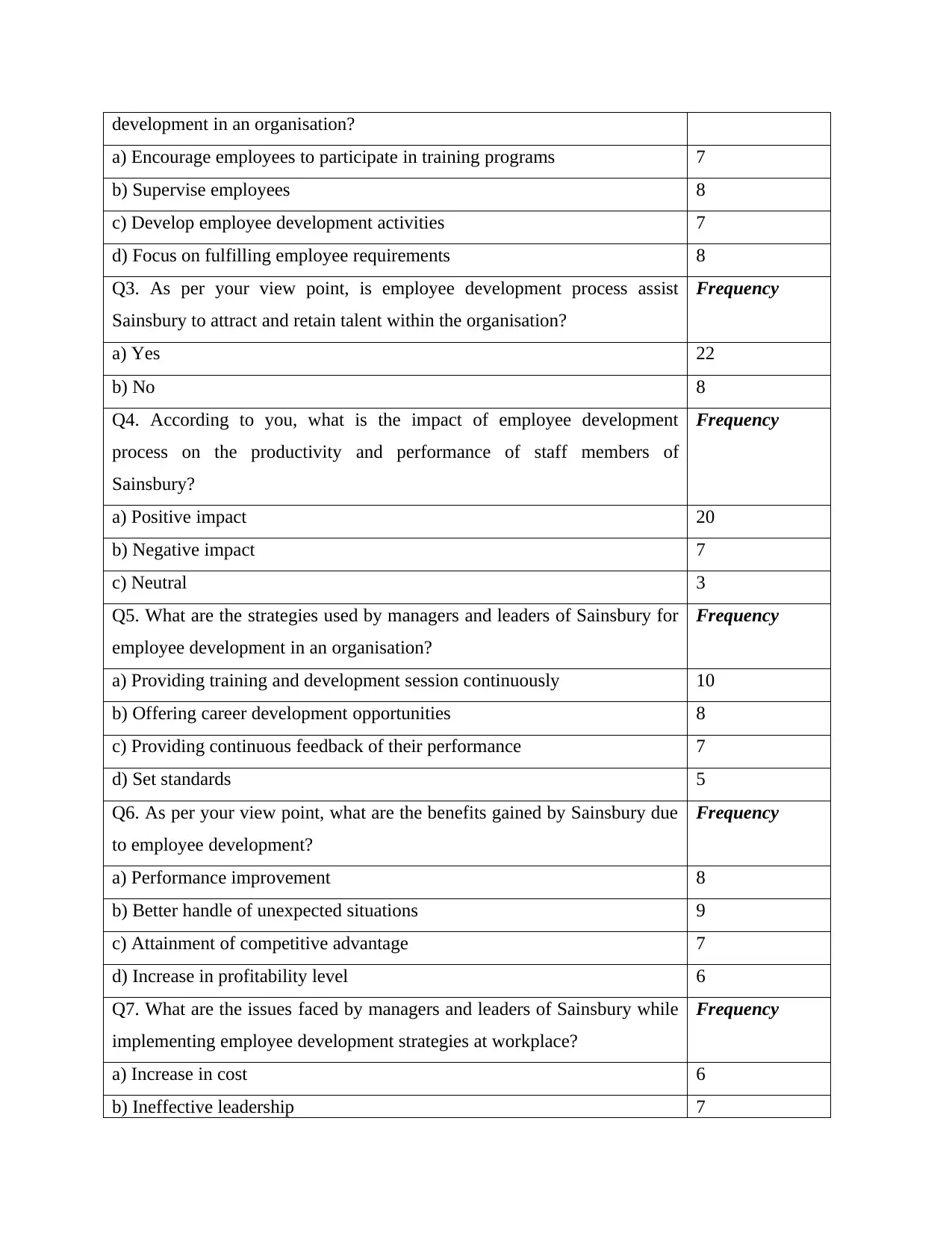
development in an organisation?
a) Encourage employees to participate in training programs 7
b) Supervise employees 8
c) Develop employee development activities 7
d) Focus on fulfilling employee requirements 8
Q3. As per your view point, is employee development process assist
Sainsbury to attract and retain talent within the organisation?
Frequency
a) Yes 22
b) No 8
Q4. According to you, what is the impact of employee development
process on the productivity and performance of staff members of
Sainsbury?
Frequency
a) Positive impact 20
b) Negative impact 7
c) Neutral 3
Q5. What are the strategies used by managers and leaders of Sainsbury for
employee development in an organisation?
Frequency
a) Providing training and development session continuously 10
b) Offering career development opportunities 8
c) Providing continuous feedback of their performance 7
d) Set standards 5
Q6. As per your view point, what are the benefits gained by Sainsbury due
to employee development?
Frequency
a) Performance improvement 8
b) Better handle of unexpected situations 9
c) Attainment of competitive advantage 7
d) Increase in profitability level 6
Q7. What are the issues faced by managers and leaders of Sainsbury while
implementing employee development strategies at workplace?
Frequency
a) Increase in cost 6
b) Ineffective leadership 7
a) Encourage employees to participate in training programs 7
b) Supervise employees 8
c) Develop employee development activities 7
d) Focus on fulfilling employee requirements 8
Q3. As per your view point, is employee development process assist
Sainsbury to attract and retain talent within the organisation?
Frequency
a) Yes 22
b) No 8
Q4. According to you, what is the impact of employee development
process on the productivity and performance of staff members of
Sainsbury?
Frequency
a) Positive impact 20
b) Negative impact 7
c) Neutral 3
Q5. What are the strategies used by managers and leaders of Sainsbury for
employee development in an organisation?
Frequency
a) Providing training and development session continuously 10
b) Offering career development opportunities 8
c) Providing continuous feedback of their performance 7
d) Set standards 5
Q6. As per your view point, what are the benefits gained by Sainsbury due
to employee development?
Frequency
a) Performance improvement 8
b) Better handle of unexpected situations 9
c) Attainment of competitive advantage 7
d) Increase in profitability level 6
Q7. What are the issues faced by managers and leaders of Sainsbury while
implementing employee development strategies at workplace?
Frequency
a) Increase in cost 6
b) Ineffective leadership 7
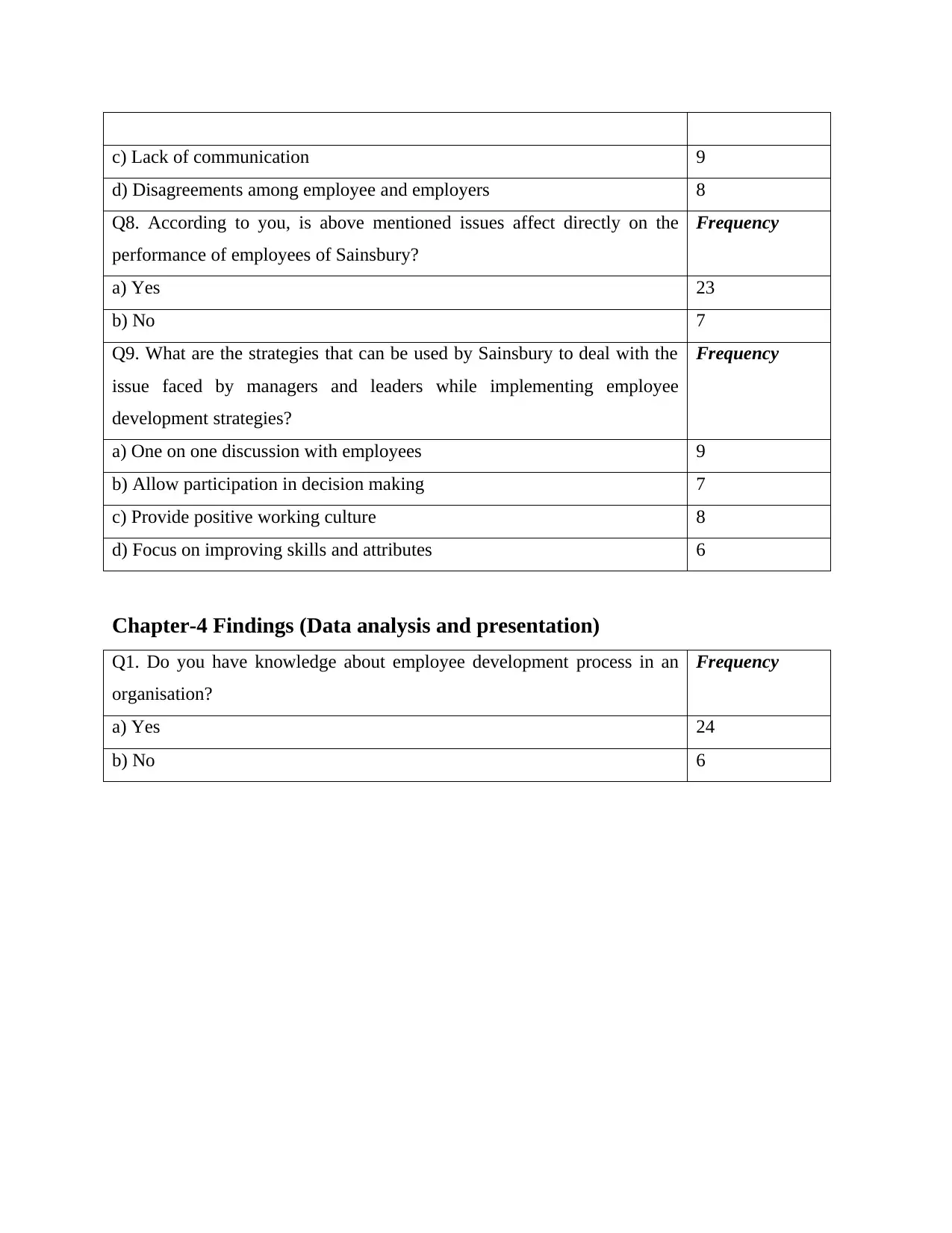
c) Lack of communication 9
d) Disagreements among employee and employers 8
Q8. According to you, is above mentioned issues affect directly on the
performance of employees of Sainsbury?
Frequency
a) Yes 23
b) No 7
Q9. What are the strategies that can be used by Sainsbury to deal with the
issue faced by managers and leaders while implementing employee
development strategies?
Frequency
a) One on one discussion with employees 9
b) Allow participation in decision making 7
c) Provide positive working culture 8
d) Focus on improving skills and attributes 6
Chapter-4 Findings (Data analysis and presentation)
Q1. Do you have knowledge about employee development process in an
organisation?
Frequency
a) Yes 24
b) No 6
d) Disagreements among employee and employers 8
Q8. According to you, is above mentioned issues affect directly on the
performance of employees of Sainsbury?
Frequency
a) Yes 23
b) No 7
Q9. What are the strategies that can be used by Sainsbury to deal with the
issue faced by managers and leaders while implementing employee
development strategies?
Frequency
a) One on one discussion with employees 9
b) Allow participation in decision making 7
c) Provide positive working culture 8
d) Focus on improving skills and attributes 6
Chapter-4 Findings (Data analysis and presentation)
Q1. Do you have knowledge about employee development process in an
organisation?
Frequency
a) Yes 24
b) No 6
⊘ This is a preview!⊘
Do you want full access?
Subscribe today to unlock all pages.

Trusted by 1+ million students worldwide
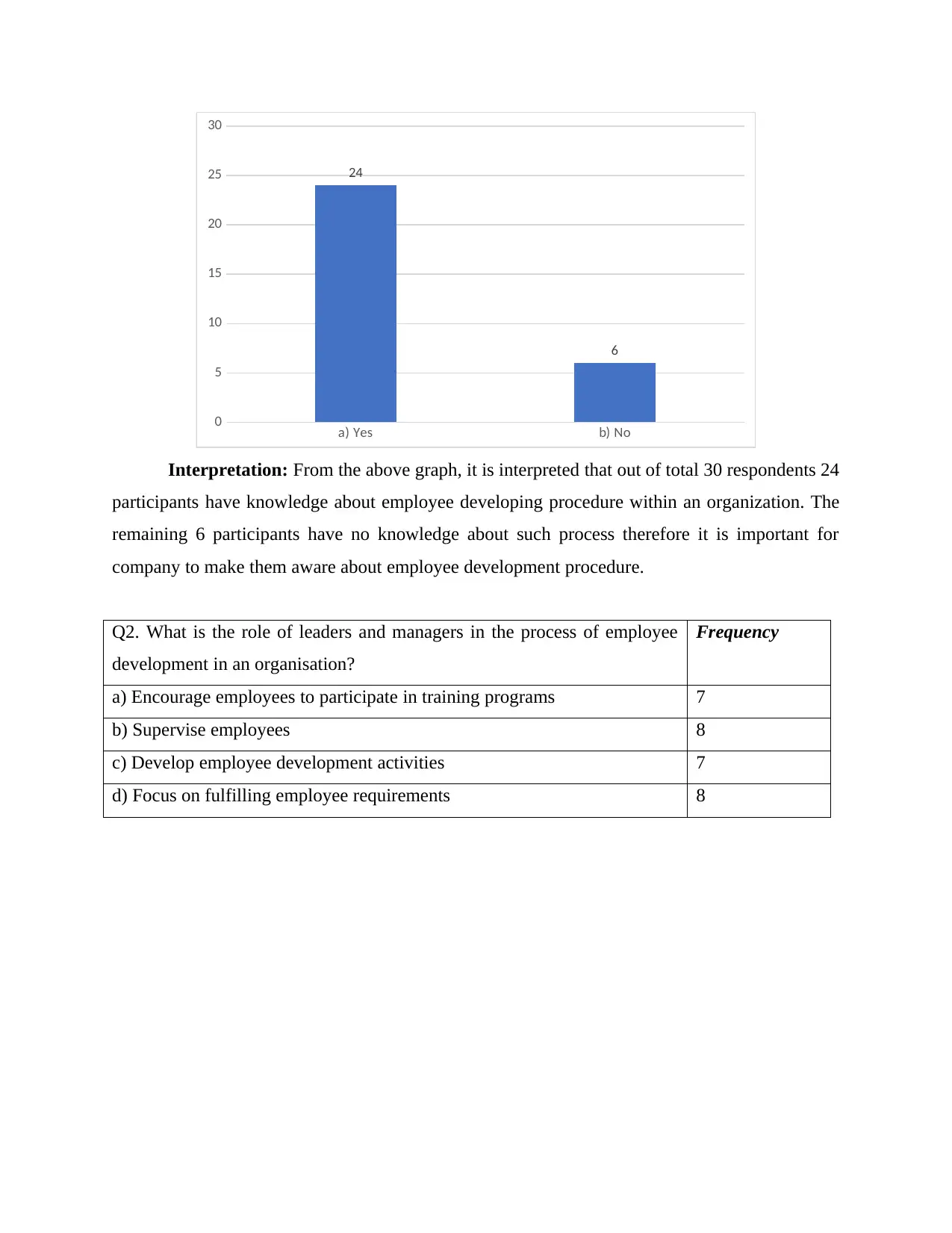
a) Yes b) No
0
5
10
15
20
25
30
24
6
Interpretation: From the above graph, it is interpreted that out of total 30 respondents 24
participants have knowledge about employee developing procedure within an organization. The
remaining 6 participants have no knowledge about such process therefore it is important for
company to make them aware about employee development procedure.
Q2. What is the role of leaders and managers in the process of employee
development in an organisation?
Frequency
a) Encourage employees to participate in training programs 7
b) Supervise employees 8
c) Develop employee development activities 7
d) Focus on fulfilling employee requirements 8
0
5
10
15
20
25
30
24
6
Interpretation: From the above graph, it is interpreted that out of total 30 respondents 24
participants have knowledge about employee developing procedure within an organization. The
remaining 6 participants have no knowledge about such process therefore it is important for
company to make them aware about employee development procedure.
Q2. What is the role of leaders and managers in the process of employee
development in an organisation?
Frequency
a) Encourage employees to participate in training programs 7
b) Supervise employees 8
c) Develop employee development activities 7
d) Focus on fulfilling employee requirements 8
Paraphrase This Document
Need a fresh take? Get an instant paraphrase of this document with our AI Paraphraser
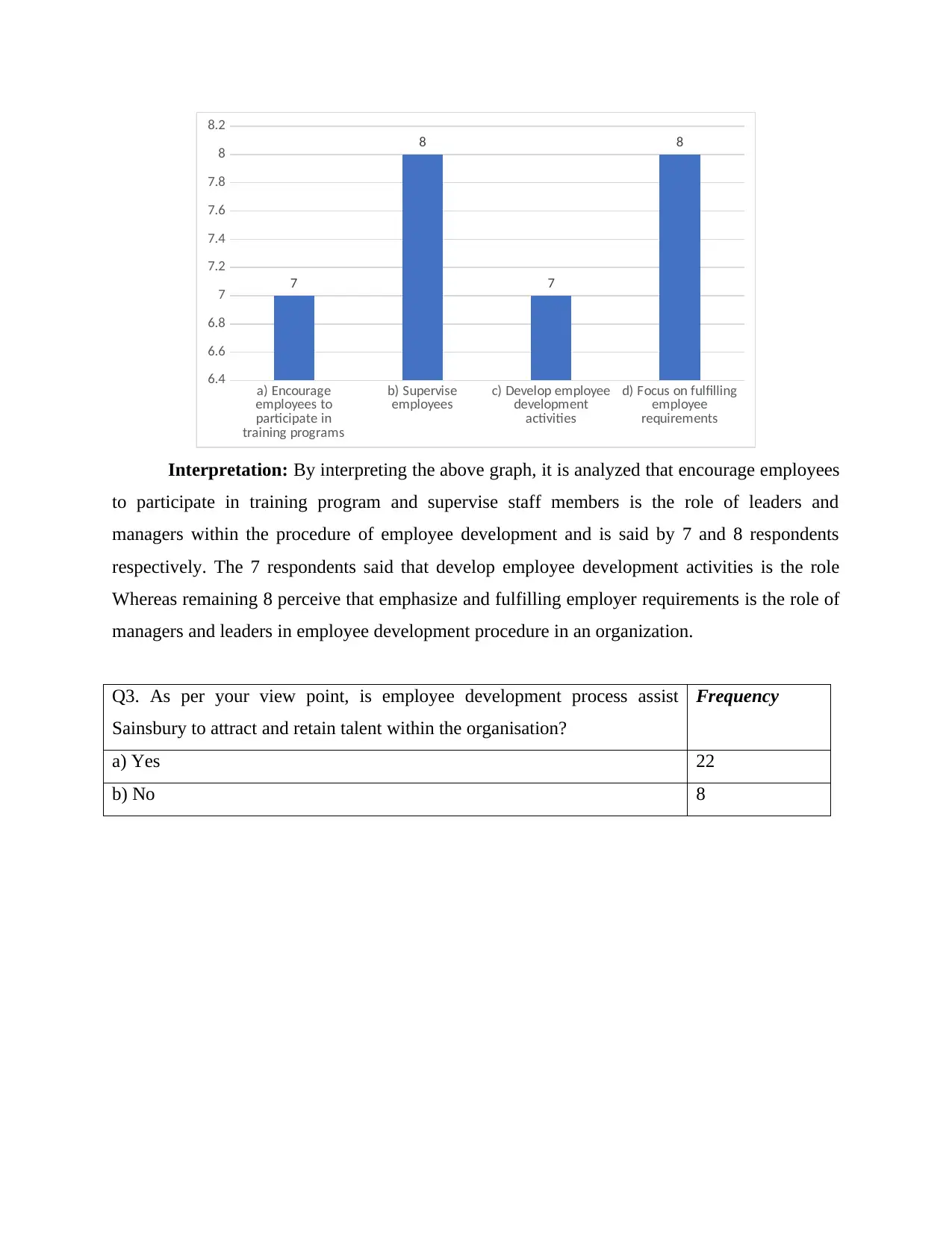
a) Encourage
employees to
participate in
training programs
b) Supervise
employees c) Develop employee
development
activities
d) Focus on fulfilling
employee
requirements
6.4
6.6
6.8
7
7.2
7.4
7.6
7.8
8
8.2
7
8
7
8
Interpretation: By interpreting the above graph, it is analyzed that encourage employees
to participate in training program and supervise staff members is the role of leaders and
managers within the procedure of employee development and is said by 7 and 8 respondents
respectively. The 7 respondents said that develop employee development activities is the role
Whereas remaining 8 perceive that emphasize and fulfilling employer requirements is the role of
managers and leaders in employee development procedure in an organization.
Q3. As per your view point, is employee development process assist
Sainsbury to attract and retain talent within the organisation?
Frequency
a) Yes 22
b) No 8
employees to
participate in
training programs
b) Supervise
employees c) Develop employee
development
activities
d) Focus on fulfilling
employee
requirements
6.4
6.6
6.8
7
7.2
7.4
7.6
7.8
8
8.2
7
8
7
8
Interpretation: By interpreting the above graph, it is analyzed that encourage employees
to participate in training program and supervise staff members is the role of leaders and
managers within the procedure of employee development and is said by 7 and 8 respondents
respectively. The 7 respondents said that develop employee development activities is the role
Whereas remaining 8 perceive that emphasize and fulfilling employer requirements is the role of
managers and leaders in employee development procedure in an organization.
Q3. As per your view point, is employee development process assist
Sainsbury to attract and retain talent within the organisation?
Frequency
a) Yes 22
b) No 8
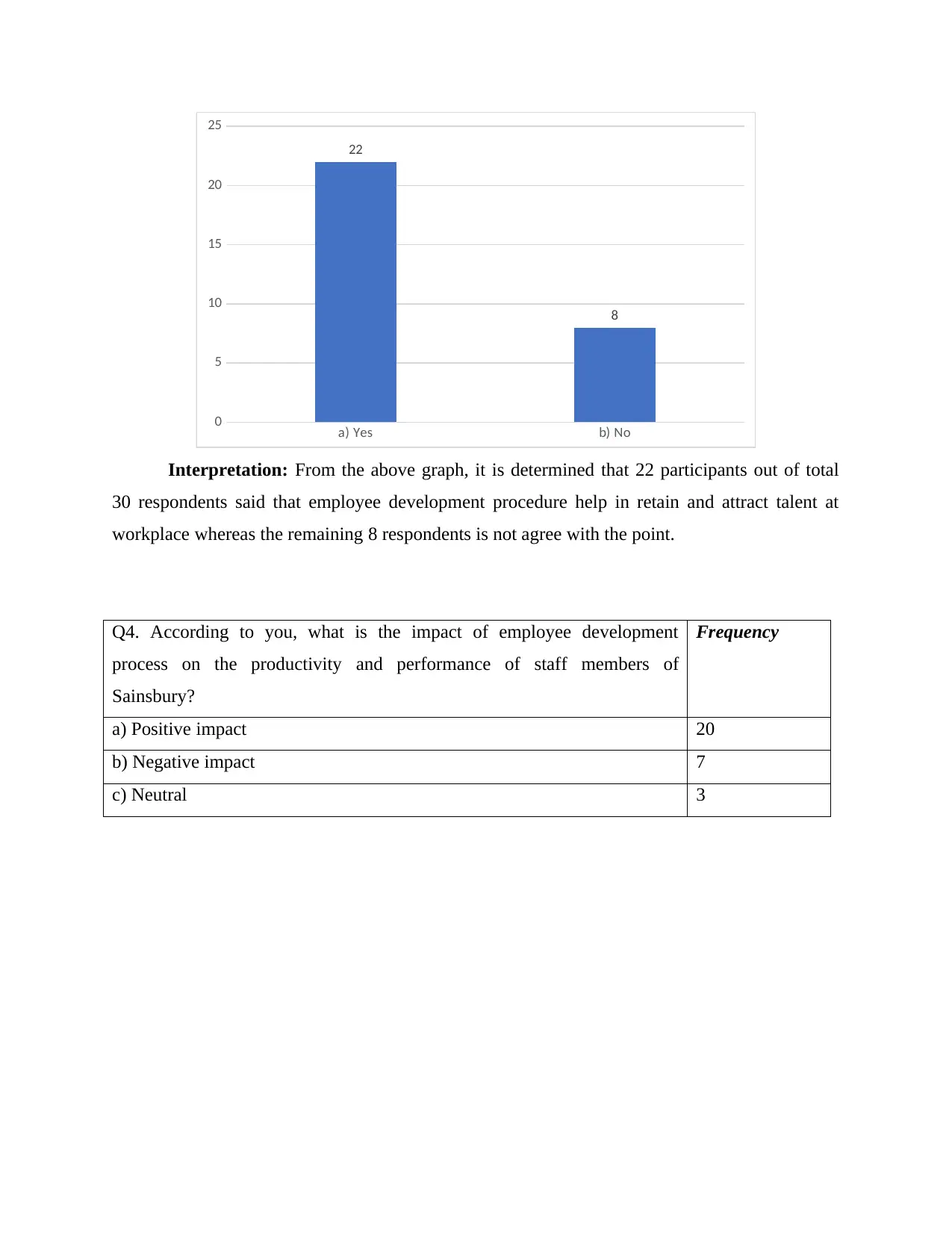
a) Yes b) No
0
5
10
15
20
25
22
8
Interpretation: From the above graph, it is determined that 22 participants out of total
30 respondents said that employee development procedure help in retain and attract talent at
workplace whereas the remaining 8 respondents is not agree with the point.
Q4. According to you, what is the impact of employee development
process on the productivity and performance of staff members of
Sainsbury?
Frequency
a) Positive impact 20
b) Negative impact 7
c) Neutral 3
0
5
10
15
20
25
22
8
Interpretation: From the above graph, it is determined that 22 participants out of total
30 respondents said that employee development procedure help in retain and attract talent at
workplace whereas the remaining 8 respondents is not agree with the point.
Q4. According to you, what is the impact of employee development
process on the productivity and performance of staff members of
Sainsbury?
Frequency
a) Positive impact 20
b) Negative impact 7
c) Neutral 3
⊘ This is a preview!⊘
Do you want full access?
Subscribe today to unlock all pages.

Trusted by 1+ million students worldwide
1 out of 24
Related Documents
Your All-in-One AI-Powered Toolkit for Academic Success.
+13062052269
info@desklib.com
Available 24*7 on WhatsApp / Email
![[object Object]](/_next/static/media/star-bottom.7253800d.svg)
Unlock your academic potential
Copyright © 2020–2025 A2Z Services. All Rights Reserved. Developed and managed by ZUCOL.




